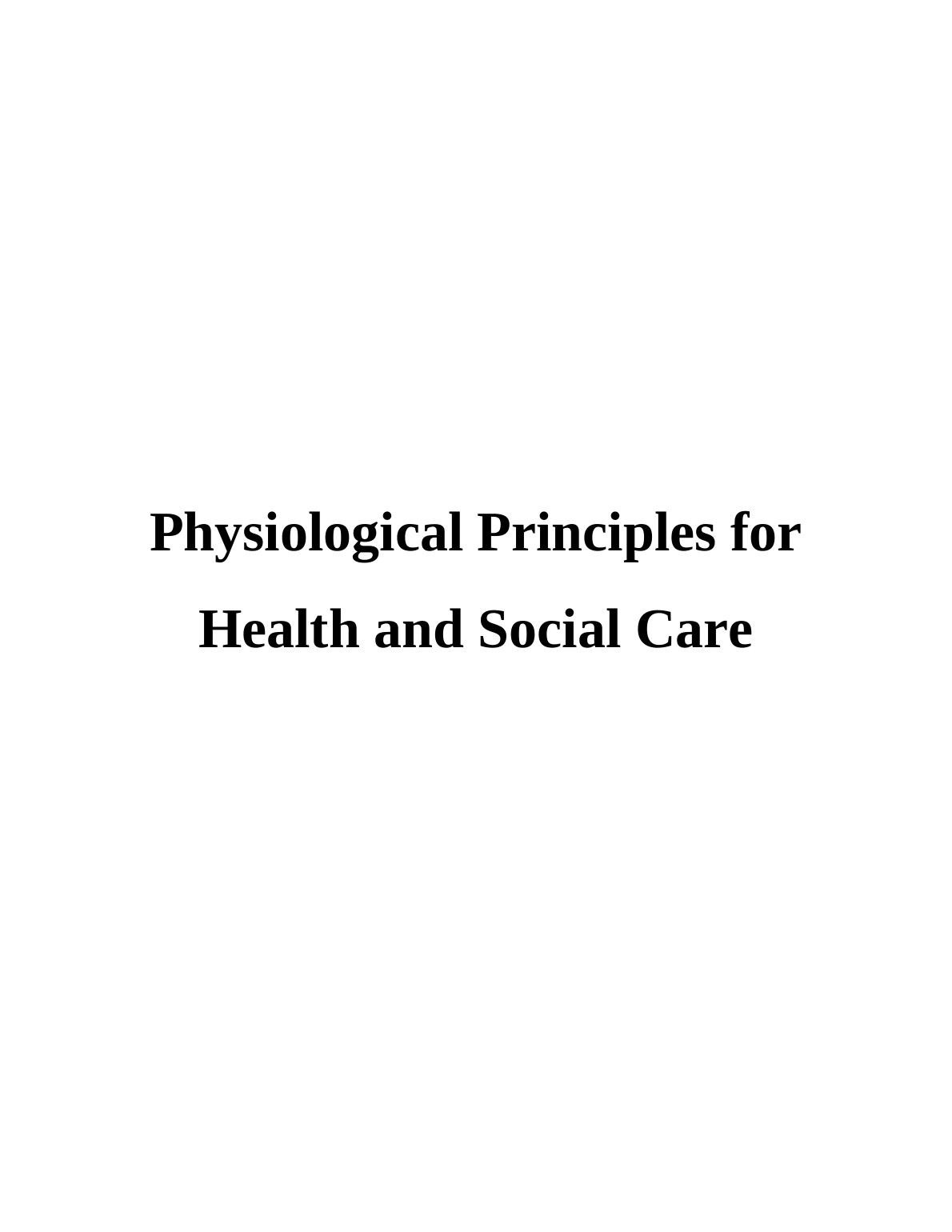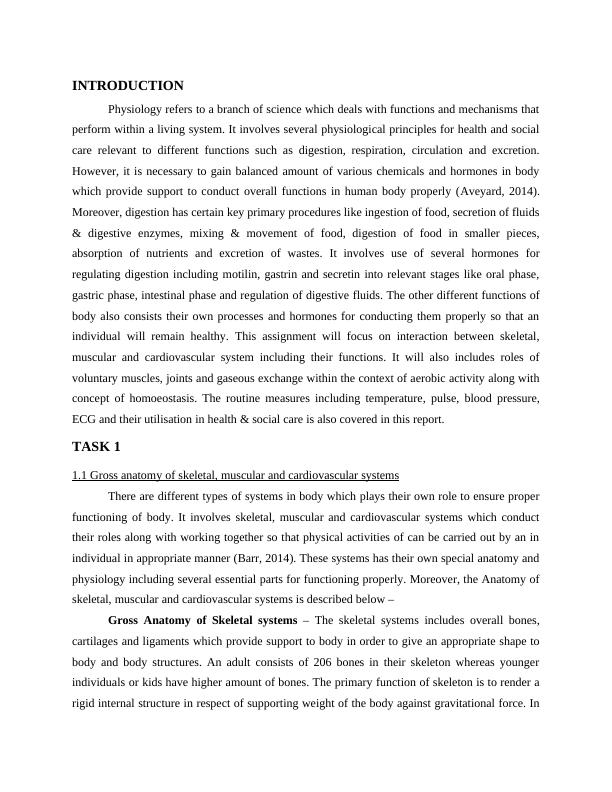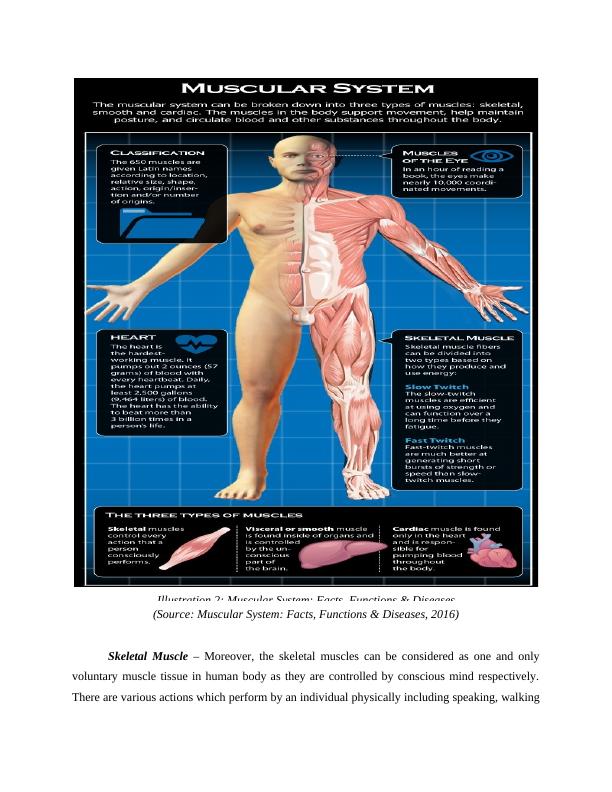Physiological Principles for Health and Social Care
21 Pages6945 Words479 Views
Added on 2020-12-18
About This Document
Physiological Principles for Health and Social Care INTRODUCTION 1 TASK 11 1.1 Gross anatomy of skeletal, muscular and cardiovascular systems 1 1.2 Functions of skeletal, muscular and cardiovascular systems along with their working together 6 TASK 28 2.1 Response of body to physical activities 8 2.2 Role of voluntary muscles, joints & gaseous skeleton exchange within context of aerobic activity 9 2.3 Maintaining homoeostasis during the action in given scenario 10 TASK 312 3.1 Ethical considerations of routine measurement of temperature, pulse, BP, ECG and their
Physiological Principles for Health and Social Care
Added on 2020-12-18
ShareRelated Documents
Physiological Principles for
Health and Social Care
Health and Social Care

Table of Contents
INTRODUCTION...........................................................................................................................1
TASK 1 ...........................................................................................................................................1
1.1 Gross anatomy of skeletal, muscular and cardiovascular systems...................................1
1.2 Functions of skeletal, muscular and cardiovascular systems along with their working
together...................................................................................................................................6
TASK 2 ...........................................................................................................................................8
2.1 Response of body to physical activities............................................................................8
2.2 Role of voluntary muscles, joints & gaseous exchange within context of aerobic activity..9
2.3 Maintaining homoeostasis during the action in given scenario......................................10
TASK 3 .........................................................................................................................................12
3.1 Ethical considerations of routine measurement of temperature, pulse, BP, ECG and their
use in healthcare...................................................................................................................12
3.2 Information about functioning of body through Temperature, Pulse, BP and ECG......13
3.3 How such information helps in care planning of a person.............................................14
TASK 4..........................................................................................................................................15
4.1 Impact of Mary's age on body structure and functioning...............................................15
4.2 Impacts of her medical condition on body structure and functions................................16
4.3 Evaluate effective routine care delivered to Mary favourable for her overall physical
condition...............................................................................................................................16
CONCLUSION..............................................................................................................................17
REFERENCES..............................................................................................................................18
INTRODUCTION...........................................................................................................................1
TASK 1 ...........................................................................................................................................1
1.1 Gross anatomy of skeletal, muscular and cardiovascular systems...................................1
1.2 Functions of skeletal, muscular and cardiovascular systems along with their working
together...................................................................................................................................6
TASK 2 ...........................................................................................................................................8
2.1 Response of body to physical activities............................................................................8
2.2 Role of voluntary muscles, joints & gaseous exchange within context of aerobic activity..9
2.3 Maintaining homoeostasis during the action in given scenario......................................10
TASK 3 .........................................................................................................................................12
3.1 Ethical considerations of routine measurement of temperature, pulse, BP, ECG and their
use in healthcare...................................................................................................................12
3.2 Information about functioning of body through Temperature, Pulse, BP and ECG......13
3.3 How such information helps in care planning of a person.............................................14
TASK 4..........................................................................................................................................15
4.1 Impact of Mary's age on body structure and functioning...............................................15
4.2 Impacts of her medical condition on body structure and functions................................16
4.3 Evaluate effective routine care delivered to Mary favourable for her overall physical
condition...............................................................................................................................16
CONCLUSION..............................................................................................................................17
REFERENCES..............................................................................................................................18

INTRODUCTION
Physiology refers to a branch of science which deals with functions and mechanisms that
perform within a living system. It involves several physiological principles for health and social
care relevant to different functions such as digestion, respiration, circulation and excretion.
However, it is necessary to gain balanced amount of various chemicals and hormones in body
which provide support to conduct overall functions in human body properly (Aveyard, 2014).
Moreover, digestion has certain key primary procedures like ingestion of food, secretion of fluids
& digestive enzymes, mixing & movement of food, digestion of food in smaller pieces,
absorption of nutrients and excretion of wastes. It involves use of several hormones for
regulating digestion including motilin, gastrin and secretin into relevant stages like oral phase,
gastric phase, intestinal phase and regulation of digestive fluids. The other different functions of
body also consists their own processes and hormones for conducting them properly so that an
individual will remain healthy. This assignment will focus on interaction between skeletal,
muscular and cardiovascular system including their functions. It will also includes roles of
voluntary muscles, joints and gaseous exchange within the context of aerobic activity along with
concept of homoeostasis. The routine measures including temperature, pulse, blood pressure,
ECG and their utilisation in health & social care is also covered in this report.
TASK 1
1.1 Gross anatomy of skeletal, muscular and cardiovascular systems
There are different types of systems in body which plays their own role to ensure proper
functioning of body. It involves skeletal, muscular and cardiovascular systems which conduct
their roles along with working together so that physical activities of can be carried out by an in
individual in appropriate manner (Barr, 2014). These systems has their own special anatomy and
physiology including several essential parts for functioning properly. Moreover, the Anatomy of
skeletal, muscular and cardiovascular systems is described below –
Gross Anatomy of Skeletal systems – The skeletal systems includes overall bones,
cartilages and ligaments which provide support to body in order to give an appropriate shape to
body and body structures. An adult consists of 206 bones in their skeleton whereas younger
individuals or kids have higher amount of bones. The primary function of skeleton is to render a
rigid internal structure in respect of supporting weight of the body against gravitational force. In
Physiology refers to a branch of science which deals with functions and mechanisms that
perform within a living system. It involves several physiological principles for health and social
care relevant to different functions such as digestion, respiration, circulation and excretion.
However, it is necessary to gain balanced amount of various chemicals and hormones in body
which provide support to conduct overall functions in human body properly (Aveyard, 2014).
Moreover, digestion has certain key primary procedures like ingestion of food, secretion of fluids
& digestive enzymes, mixing & movement of food, digestion of food in smaller pieces,
absorption of nutrients and excretion of wastes. It involves use of several hormones for
regulating digestion including motilin, gastrin and secretin into relevant stages like oral phase,
gastric phase, intestinal phase and regulation of digestive fluids. The other different functions of
body also consists their own processes and hormones for conducting them properly so that an
individual will remain healthy. This assignment will focus on interaction between skeletal,
muscular and cardiovascular system including their functions. It will also includes roles of
voluntary muscles, joints and gaseous exchange within the context of aerobic activity along with
concept of homoeostasis. The routine measures including temperature, pulse, blood pressure,
ECG and their utilisation in health & social care is also covered in this report.
TASK 1
1.1 Gross anatomy of skeletal, muscular and cardiovascular systems
There are different types of systems in body which plays their own role to ensure proper
functioning of body. It involves skeletal, muscular and cardiovascular systems which conduct
their roles along with working together so that physical activities of can be carried out by an in
individual in appropriate manner (Barr, 2014). These systems has their own special anatomy and
physiology including several essential parts for functioning properly. Moreover, the Anatomy of
skeletal, muscular and cardiovascular systems is described below –
Gross Anatomy of Skeletal systems – The skeletal systems includes overall bones,
cartilages and ligaments which provide support to body in order to give an appropriate shape to
body and body structures. An adult consists of 206 bones in their skeleton whereas younger
individuals or kids have higher amount of bones. The primary function of skeleton is to render a
rigid internal structure in respect of supporting weight of the body against gravitational force. In

addition to this, it is helpful to provide structure upon muscles which facilitate to produce desired
movements of the body in terms of conducting may physical activities in daily routine of people.
Moreover, it can be divided into two parts such as axial and appendicular skeleton (Corin, 2017).
(Source: Skeletal System, 2017)
The Axial Skeleton
The axial skeleton consist of vertical central axis of the body including overall bones of
head, neck, chest and back (Davis Boykins, 2014). It will provide support to protect brain, spinal
chord, heart and lungs along with serving an attachment site for those muscles who plays an
important role in movement of head, neck, back and muscles of hip points in order move their
corresponding limbs. However, an axial skeleton contains 80 bones which includes skull formed
Illustration 1: Skeletal System
movements of the body in terms of conducting may physical activities in daily routine of people.
Moreover, it can be divided into two parts such as axial and appendicular skeleton (Corin, 2017).
(Source: Skeletal System, 2017)
The Axial Skeleton
The axial skeleton consist of vertical central axis of the body including overall bones of
head, neck, chest and back (Davis Boykins, 2014). It will provide support to protect brain, spinal
chord, heart and lungs along with serving an attachment site for those muscles who plays an
important role in movement of head, neck, back and muscles of hip points in order move their
corresponding limbs. However, an axial skeleton contains 80 bones which includes skull formed
Illustration 1: Skeletal System

by 22 bones, vertebral column and thoracic cage. The vertebral column contains 24 bones known
as vertebra along with sacrum & coccyx. Finally, thoracic cage consist of 12 pair of ribs, sternum
and flattened bone of anterior chest.
The appendicular skeleton
The appendicular skeleton involves overall bones of upper and lower limbs along with
these bones which are helpful to attach each limb to axial skeleton. However, there are 126 bones
in appendicular skeleton in an adult (Enthoven, 2014).
Gross Anatomy of Muscular systems – The muscular system is helpful in movement of
human body including different types of muscles such as visceral, cardiac and skeletal. However,
it has been observed that most of skeletal muscles are attached to two bones with the help of
tendons. The tendons refers to bands of dense regular connective tissue having strong collagen
fibre which firmly attach muscles to bones. Moreover, muscles move by shortening their length
and pulling on tendons and moving bones closer to one another. A single bone is pulled towards
the another bone which remains stationary and the place in stationary bone that is linked with the
help of tendons to the muscles known as origin. In addition to this, the area on the moving bone
which is associated to muscle through tendons is considered as an insertion. Meanwhile, belly of
muscles is a fleshy part of muscle in between the tendons that does the actual contraction.
Visceral Muscle - Initially, visceral muscles are usually found outside the organs
including stomach, intestines and blood vessels. However, visceral muscles are responsible to
make organs in order to contract to move substances through the specific organ. These muscles
are also known as involuntary muscles because they are controlled by unconscious mind and it
cannot directly controlled through conscious mind (Eyles and Woods, 2014).
Cardiac Muscle – Secondly, cardiac muscles are found in heart which conduct an
important function of pumping blood throughout the overall body and it is also a kind of
involuntary muscle. While, hormones and signals from brain adjust rate of contraction and
cardiac muscles stimulates themselves to contract. The ability of self stimulation, cardiac
muscles are known as auto rhythmic or intrinsically controlled.
as vertebra along with sacrum & coccyx. Finally, thoracic cage consist of 12 pair of ribs, sternum
and flattened bone of anterior chest.
The appendicular skeleton
The appendicular skeleton involves overall bones of upper and lower limbs along with
these bones which are helpful to attach each limb to axial skeleton. However, there are 126 bones
in appendicular skeleton in an adult (Enthoven, 2014).
Gross Anatomy of Muscular systems – The muscular system is helpful in movement of
human body including different types of muscles such as visceral, cardiac and skeletal. However,
it has been observed that most of skeletal muscles are attached to two bones with the help of
tendons. The tendons refers to bands of dense regular connective tissue having strong collagen
fibre which firmly attach muscles to bones. Moreover, muscles move by shortening their length
and pulling on tendons and moving bones closer to one another. A single bone is pulled towards
the another bone which remains stationary and the place in stationary bone that is linked with the
help of tendons to the muscles known as origin. In addition to this, the area on the moving bone
which is associated to muscle through tendons is considered as an insertion. Meanwhile, belly of
muscles is a fleshy part of muscle in between the tendons that does the actual contraction.
Visceral Muscle - Initially, visceral muscles are usually found outside the organs
including stomach, intestines and blood vessels. However, visceral muscles are responsible to
make organs in order to contract to move substances through the specific organ. These muscles
are also known as involuntary muscles because they are controlled by unconscious mind and it
cannot directly controlled through conscious mind (Eyles and Woods, 2014).
Cardiac Muscle – Secondly, cardiac muscles are found in heart which conduct an
important function of pumping blood throughout the overall body and it is also a kind of
involuntary muscle. While, hormones and signals from brain adjust rate of contraction and
cardiac muscles stimulates themselves to contract. The ability of self stimulation, cardiac
muscles are known as auto rhythmic or intrinsically controlled.

(Source: Muscular System: Facts, Functions & Diseases, 2016)
Skeletal Muscle – Moreover, the skeletal muscles can be considered as one and only
voluntary muscle tissue in human body as they are controlled by conscious mind respectively.
There are various actions which perform by an individual physically including speaking, walking
Illustration 2: Muscular System: Facts, Functions & Diseases
Skeletal Muscle – Moreover, the skeletal muscles can be considered as one and only
voluntary muscle tissue in human body as they are controlled by conscious mind respectively.
There are various actions which perform by an individual physically including speaking, walking
Illustration 2: Muscular System: Facts, Functions & Diseases

End of preview
Want to access all the pages? Upload your documents or become a member.
Related Documents
Physiological Principles for Health and Social Carelg...
|14
|5274
|475
Physiological Principles for Health and Social Care : Reportlg...
|20
|7196
|163
Physiological Principles for Health and Social Care Reportlg...
|17
|4802
|180
Physiological Principles for Health and Social Care Doclg...
|20
|6332
|342
Physiological Principles for Health and Social Carelg...
|17
|5840
|91
